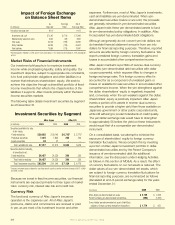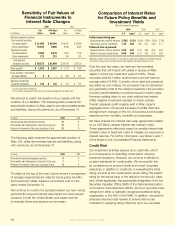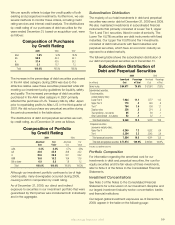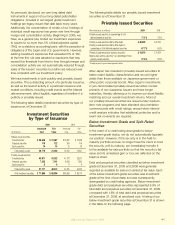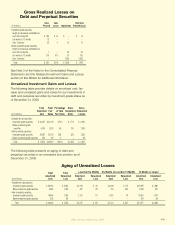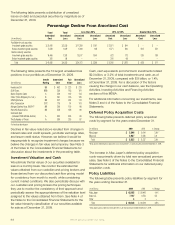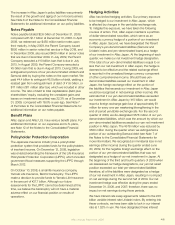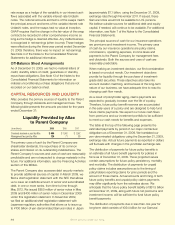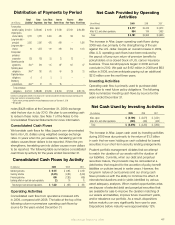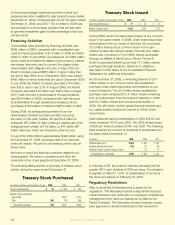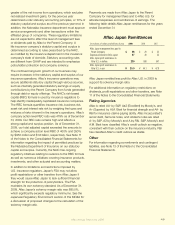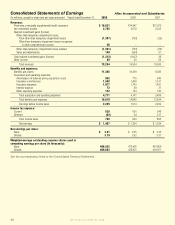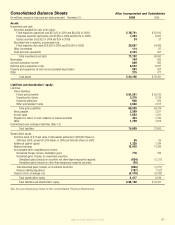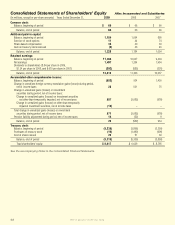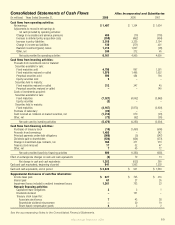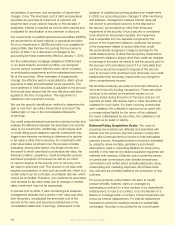Aflac 2009 Annual Report Download - page 50
Download and view the complete annual report
Please find page 50 of the 2009 Aflac annual report below. You can navigate through the pages in the report by either clicking on the pages listed below, or by using the keyword search tool below to find specific information within the annual report.
rate swaps as a hedge of the variability in our interest cash
ows associated with the variable interest rate Uridashi
notes. The notional amounts and terms of the swaps match
the principal amount and terms of the variable interest rate
Uridashi notes, and the swaps had no value at inception.
GAAP requires that the change in the fair value of the swap
contracts be recorded in other comprehensive income so
long as the hedge is deemed effective. Any ineffectiveness
is recognized in net earnings (other income). These hedges
were effective during the three-year period ended December
31, 2009; therefore, there was no impact on net earnings.
See Note 4 of the Notes to the Consolidated Financial
Statements for additional information.
Off-Balance Sheet Arrangements
As of December 31, 2009, we had no material letters of
credit, standby letters of credit, guarantees or standby
repurchase obligations. See Note 13 of the Notes to the
Consolidated Financial Statements for information on
material unconditional purchase obligations that are not
recorded on our balance sheet.
CAPITAL RESOURCES AND LIQUIDITY
Aac provides the primary sources of liquidity to the Parent
Company through dividends and management fees. The
following table presents the amounts provided for the years
ended December 31:
The primary uses of cash by the Parent Company are
shareholder dividends, the repurchase of its common
shares and interest on its outstanding indebtedness. The
Parent Company’s sources and uses of cash are reasonably
predictable and are not expected to change materially in the
future. For additional information, see the Financing Activities
section of this MD&A.
The Parent Company also accesses debt security markets
to provide additional sources of capital. In March 2009, we
led a shelf registration statement with the SEC that allows
us to issue an indenite amount of senior and subordinated
debt, in one or more series, from time to time through
May 2012. We issued $850 million of senior notes in May
2009 and $400 million of senior notes in December 2009
under this registration statement. In November 2009,
we led an additional shelf registration statement with
Japanese regulatory authorities that allows us to issue up
to ¥100 billion of yen-denominated Samurai notes in Japan
(approximately $1.1 billion, using the December 31, 2009,
exchange rate) through November 2011. If issued, these
Samurai notes would not be available to U.S. persons.
We believe outside sources for additional debt and equity
capital, if needed, will continue to be available. For additional
information, see Note 7 of the Notes to the Consolidated
Financial Statements.
The principal sources of cash for our insurance operations
are premiums and investment income. The primary uses
of cash by our insurance operations are policy claims,
commissions, operating expenses, income taxes and
payments to the Parent Company for management fees
and dividends. Both the sources and uses of cash are
reasonably predictable.
When making an investment decision, our rst consideration
is based on product needs. Our investment objectives
provide for liquidity through the purchase of investment-
grade debt securities. These objectives also take into
account duration matching, and because of the long-term
nature of our business, we have adequate time to react to
changing cash ow needs.
As a result of policyholder aging, claims payments are
expected to gradually increase over the life of a policy.
Therefore, future policy benet reserves are accumulated
in the early years of a policy and are designed to help fund
future claims payments. We expect our future cash ows
from premiums and our investment portfolio to be sufcient
to meet our cash needs for benets and expenses.
The table at the top of the following page presents the
estimated payments by period of our major contractual
obligations as of December 31, 2009. We translated our
yen-denominated obligations using the December 31, 2009,
exchange rate. Actual future payments as reported in dollars
will uctuate with changes in the yen/dollar exchange rate.
The distribution of payments for future policy benets is
an estimate of all future benet payments for policies in
force as of December 31, 2009. These projected values
contain assumptions for future policy persistency, mortality
and morbidity. The distribution of payments for unpaid
policy claims includes assumptions as to the timing of
policyholders reporting claims for prior periods and the
amount of those claims. Actual amounts and timing of both
future policy benets and unpaid policy claims payments
may differ signicantly from the estimates above. We
anticipate that the future policy benet liability of $61.5 billion
at December 31, 2009, along with future net premiums and
investment income, will be sufcient to fund future policy
benet payments.
The distribution of payments due in less than one year for
long-term debt consists of ¥39.4 billion for our Samurai
Liquidity Provided by Aac
to Parent Company
(In millions)
2009 2008
2007
Dividends declared or paid by Aflac $ 464 $ 1,062 $ 1,362
Management fees paid by Aflac 124 71 80
We’ve got you under our wing.
46


